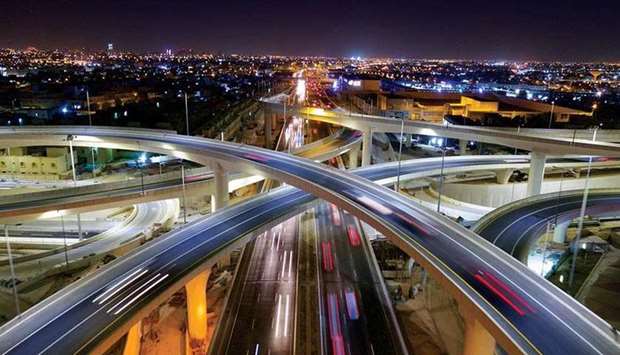The Public Works Authority (Ashghal) has opened the Sabah Al Ahmad Corridor six months ahead of the scheduled date, despite the challenges of the Covid-19 pandemic. While addressing the inaugural ceremony Wednesday, engineer Yousef al-Emadi, director of Projects Affairs at Ashghal, also announced the project will be completely delivered by the end of this year with the completion of service roads, beautification and landscaping.

The Corridor was built in appreciation of the late Amir of Kuwait, Sheikh Sabah al-Ahmad al-Jaber al-Sabah. At the beginning of the inaugural event, a short video that highlighted the life and contributions of Sheikh Sabah was screened.
The 29km Sabah Al Ahmad Corridor extends from Hamad International Airport (HIA) to Umm Lekhba Interchange on Doha Expressway. With 41km of total road works, the project significantly contributes to relieving traffic congestion on Doha Expressway, in particular, 22 February Street.
The Corridor serves about 25 residential neighbourhoods, including Al Gharrafa, Al Luqta, Al Rayyan, Al Waab and Bu Hamour, as well as many commercial, educational, health facilities and other vital utilities. Described as a vital artery in the heart of Doha, the project offers a vital alternative route that will serve thousands of daily commuters from the north to the south.







The Sabah Al Ahmad Corridor includes the construction of pedestrian crossings, including seven bridges and two pedestrian underpasses, besides 50.5km bicycle and pedestrian paths, in addition to beautification and tree plantation works along an approximate area of 355,642sqm. Qatar's first cable-stayed bridge, longest bridge, longest and deepest tunnel and largest intersection are part of the prestigious project.
Commuters from HIA via the new corridor will be able to reach Umm Lekhba Intersection in approximately 18 minutes compared to the current 50 minutes via Doha Expressway and 22 February Street, reducing traffic time by 70%.




The Corridor will also form the main link between the north and the south of Doha and create a vital connection between Doha Expressway and Southern Part of Doha Express Highway (Al Wakra Bypass) as well as to Mesaieed Road further south through Al Watiyyat Interchange in Al Thumama where its distribution point to Doha Expressway on one side and to Sabah Al Ahmad Corridor on the other side.
The Corridor links the south and north of Doha without the need to pass through Doha Expressway and 22 February Street. Works as part of the corridor include upgrading E-Ring, F-Ring, Mesaimeer, Al Bustan, Bu Erayyen and Lebday roads and sections of Al Markhiya Street. In addition, Ashghal will enhance 12km of local and peripheral roads intersecting with the corridor.
The project needed 6,300,000 cu m of excavation, backfilling and paving works as well as the use of approximately 1,442,000 tonnes of asphalt and 1,520,000 cu m of reinforced concrete. The infrastructure lines installed include 220km of communication lines, about 470 km of power lines, 205km of drainage lines extension and about 77km of treated sewer lines. It is worth noting that 60% of the materials used in these works are locally made.
The 1,200m long cable-stayed bridge, which has no columns up to a distance of 150m, is supported by about 120 cables and 754 precast concrete pieces of more than 200 tonnes in weight. There are 20 columns and 16 pillars to reach the highest point of the bridge, which is 30m. The bridge is a great leap in the traffic culture of Doha due to its strategic location above Haloul interchange and Faleh bin Nasser interchange on Salwa Road, where it will catch traffic coming to and from HIA and reduce traffic pressure on parallel roads such as Wholesale Market Street and Doha Expressway.
The Corridor serves about 25 residential neighbourhoods, including Al Gharrafa, Al Luqta, Al Rayyan, Al Waab and Bu Hamour, as well as many commercial, educational, health facilities and other vital utilities. Described as a vital artery in the heart of Doha, the project offers a vital alternative route that will serve thousands of daily commuters from the north to the south.







The Sabah Al Ahmad Corridor includes the construction of pedestrian crossings, including seven bridges and two pedestrian underpasses, besides 50.5km bicycle and pedestrian paths, in addition to beautification and tree plantation works along an approximate area of 355,642sqm. Qatar's first cable-stayed bridge, longest bridge, longest and deepest tunnel and largest intersection are part of the prestigious project.
Commuters from HIA via the new corridor will be able to reach Umm Lekhba Intersection in approximately 18 minutes compared to the current 50 minutes via Doha Expressway and 22 February Street, reducing traffic time by 70%.




The Corridor will also form the main link between the north and the south of Doha and create a vital connection between Doha Expressway and Southern Part of Doha Express Highway (Al Wakra Bypass) as well as to Mesaieed Road further south through Al Watiyyat Interchange in Al Thumama where its distribution point to Doha Expressway on one side and to Sabah Al Ahmad Corridor on the other side.
The Corridor links the south and north of Doha without the need to pass through Doha Expressway and 22 February Street. Works as part of the corridor include upgrading E-Ring, F-Ring, Mesaimeer, Al Bustan, Bu Erayyen and Lebday roads and sections of Al Markhiya Street. In addition, Ashghal will enhance 12km of local and peripheral roads intersecting with the corridor.
The project needed 6,300,000 cu m of excavation, backfilling and paving works as well as the use of approximately 1,442,000 tonnes of asphalt and 1,520,000 cu m of reinforced concrete. The infrastructure lines installed include 220km of communication lines, about 470 km of power lines, 205km of drainage lines extension and about 77km of treated sewer lines. It is worth noting that 60% of the materials used in these works are locally made.
The 1,200m long cable-stayed bridge, which has no columns up to a distance of 150m, is supported by about 120 cables and 754 precast concrete pieces of more than 200 tonnes in weight. There are 20 columns and 16 pillars to reach the highest point of the bridge, which is 30m. The bridge is a great leap in the traffic culture of Doha due to its strategic location above Haloul interchange and Faleh bin Nasser interchange on Salwa Road, where it will catch traffic coming to and from HIA and reduce traffic pressure on parallel roads such as Wholesale Market Street and Doha Expressway.




